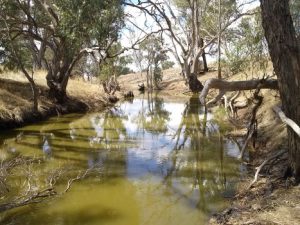In this post, Landau alumnus Felix Sauer talks about their recently published paper “Effects of salinity on leaf breakdown: Dryland salinity versus salinity from a coalmine”.

Houlaghans Creek in New South Wales, Australia: strongly influenced by dryland salinity (photo by Felix Sauer)
Salinization is deemed to be a global threat for freshwater ecosystems. In Australia, salinization is mainly driven by two factors. Dryland salinity as a result of the removal of the natural deep-rooted native vegetation, which leads to a rise of saline ground water towards the surface, and saline effluents from coal mining and coal seam gas extraction (Australia belongs, behind China and the USA, to the largest coal producers of the world).
Finally, both sources lead to increasing levels of salts in aquatic systems but their ionic composition is often completely different, potentially modulating salt-induced effects in freshwater ecosystems. In the present study, we assessed the effects of dryland salinity and coal mining on the breakdown of coarse particular organic matter (CPOM), which represents a key ecosystem function by fueling the heterotrophic food web (see also a former post), while the focus was on the microbial contribution to this function. We used a combination of field and laboratory experiments and both revealed a decrease of breakdown rates with increasing salinity. Furthermore, we observed strong indications that microbial leaf breakdown is modulated by the ionic composition of the salts and that the microbial capacity to break down leaf litter shows an inverted `U´-shaped relationship (optimum ≈ 500 µS/cm) instead of decreasing monotonously with increasing salinity. In summary, our study clearly shows that salinization is a threat for freshwater ecosystem functioning. Yet, the underlying processes that impair microorganism-mediated leaf litter breakdown are not fully understood and need further scrutiny.
The paper was authored by Felix Sauer, Mirco Bundschuh, Jochen Zubrod, Ralf Schäfer, Kristie Thompson and Ben Kefford and is published in Aquatic Toxicology.
Liked this post? You may also be interested in: Science paper from Landau: How much salt is too much salt?
